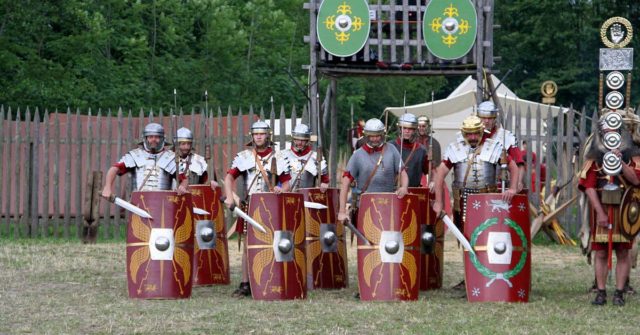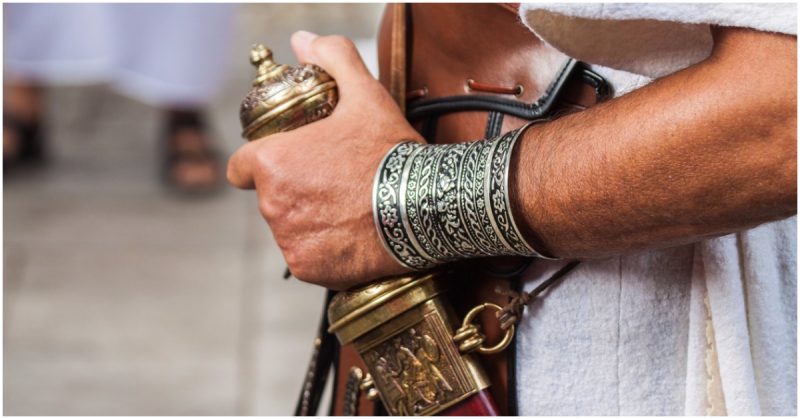The Roman army is often remembered as a highly professional force, with legionaries in segmented armor organized into centuries for close order combat. In reality, the Roman army changed a lot over the many years it dominated Europe and the Middle East. Their evolution can be divided into three broad phases – the Republican army, the reformed professional army that served the late republic and early emperors, and the army of the later empire.
The Republican Army
The army of the Roman republic was not the Roman army as we usually picture it. It was an army similar to others of the period, but their style of combat led Rome from an obscure city-state in the 8th century BC to the dominant force in Italy and beyond by the end of the 2nd century BC.
The republican army was a militia rather than a professional force. Roman citizens were duty-bound to fight when called upon, and to answer this call they were expected to use equipment appropriate to their station in society. The wealthier and more influential the citizen, the better they were to be equipped.
The first significant shift in the way this army fought came when they adopted hoplite tactics, as used by Greek colonists in Italy. They equipped themselves with shields, long spears and body armor in the form of bronze or hardened leather cuirasses. Forming phalanxes, they fought in the sort of tight formations that would become the hallmark of the Roman legions. The growing number of men fighting in these phalanxes gave great political influence to the former militiamen, who became part of the fighting elite.
The sixth century BC king Servius Tullius was credited with first organizing this army into five classes of soldiers, each carrying equipment based on their wealth, and creating units of a standard size from these men. By the 3rd century BC, this had evolved into the system Polybius recorded a century later. In this, the core of the army was the legions, each consisting of 30 maniples of 60 or 120 men, with two centuries in a maniple. They fought in three lines of maniples with offset gaps between them, the units of youngest soldiers at the front. Most soldiers carried an oval shield, a sword called a gladius, and two javelins, though the rear formations still carried a long spear.
The Post-Marian Army
The late 2nd Century saw the birth of the Roman army, in the form that most people recognize today. War with Carthage for domination of the Mediterranean tested Rome’s strength, and the citizen militia was not strong enough. A series of reforms, often attributed to the Commander Caius Marius, created an army mostly made up of professional soldiers drawn from Rome’s lower classes, each serving for 25 years.
These men were equipped by the army, rather than bringing their own weapons, and permanent service meant they gained more training, experience, and continuity of command. Officers remained aristocrats, whose careers combined war and politics.
A legion now consisted of ten cohorts, each made of six centuries of 80 men. These cohorts provided formations used to fighting together that were large enough to be effective when separated from the rest of the legion for smaller operations. All were trained and equipped in the same way as each other so that they did not have to take a specific position in the line to be effective. Each century was led by a centurion with a support staff that included a standard-bearer with his distinctive animal-skin helmet covering.
At first, these soldiers wore chain mail, though around the 1st Century AD they began wearing segmented armor which reduced flexibility in favor of greater protection. Helmets developed in quality and design over time, but the men were always equipped with plate armor helmets that included neck and cheek protection. Most carried a scutum – a rectangular shield that curved back around the soldier. This provided maximum protection and allowed a tightly packed legion to form a solid wall of shields in the face of attacks.
The gladius was still the weapon of choice for close combat, allowing short under-arm thrusts in melee. Legionaries still carried javelins, which could be thrown at the enemy to break-up their formations before an attack.

The legions were supported by cavalry formations and non-Roman auxiliary troops, who fought in less tight-packed and disciplined formations.
One of Marius’s most notable reforms was in equipment. Each legionary carried all he required not just for combat but for camping and basic military engineering. They carried so much that they became known as Marius’s mules.
The Later Empire
While the late Roman army was similar to its predecessor, it was subtly altered by the larger changes that were weakening Rome politically.
By now, most of the army was professional, including its officers. Increasing numbers of legionaries were immigrants or people from the colonies, weakening the identity of the core army, previously made up of Roman citizens. The distinction between legionary and auxiliary units blurred.
A wider range of different units existed, including a growing number of horse archers. There is some evidence that cavalry played a growing part in Roman warfare, though this may not have been as significant as some have claimed.
The increasing prominence of cavalry was one of several changes that made the Roman armies look more like the Dark Age warbands that would follow. They carried long-bladed spatha swords and round shields, rather than the gladius and pilum. Segmented armor was now largely a thing of the past.
Two types of unit existed – field troops called comitatensis and garrison troops called limitanei, usually stationed on the frontiers. The need to defend long borders forced many soldiers into stationary, defensive duty. As they connected to local areas they became the most powerful political and military forces in their localities. This may have set a precedent for later medieval warriors, who were usually military rulers dominating their surrounding communities from a fortified position.
The legions that had made Rome strong had been forced to change and some of its strength went with them. While these changes may have been for better or for worse – the point is open to discussion – the evolution of the army certainly mirrored the political and social development of Roman society as a whole.
Sources:
Adrian Goldsworthy (2003), The Complete Roman Army.
